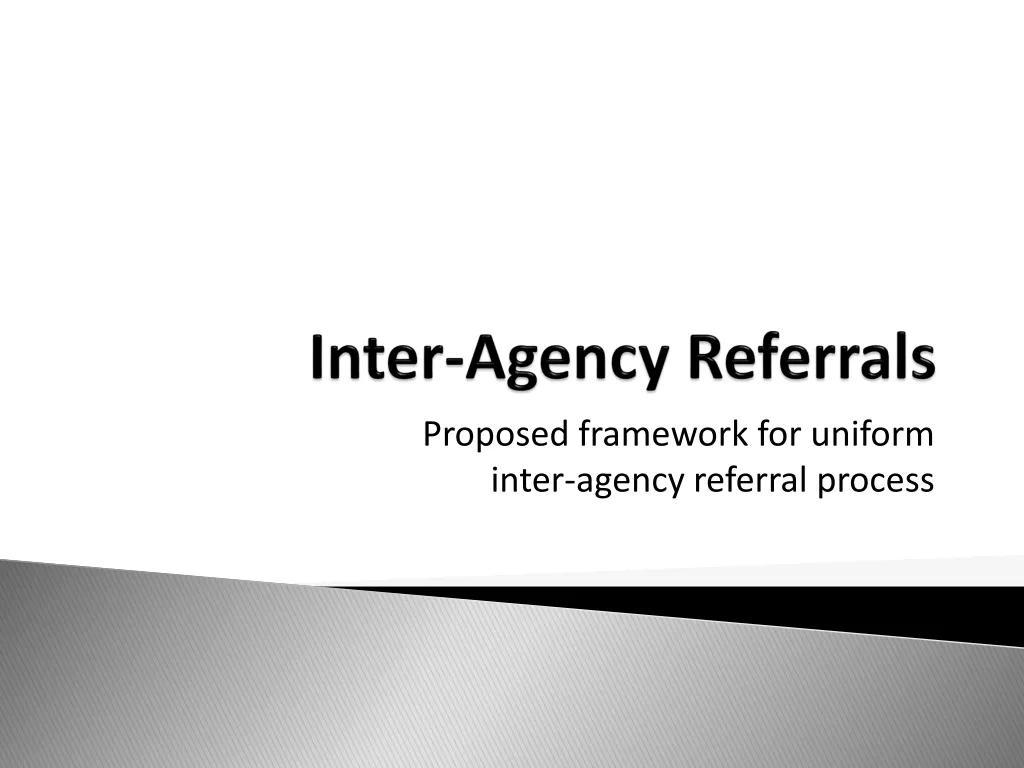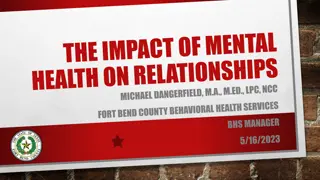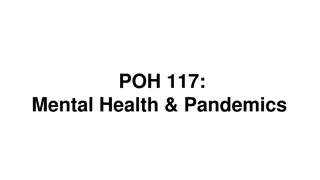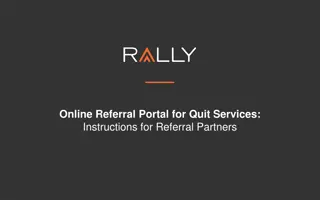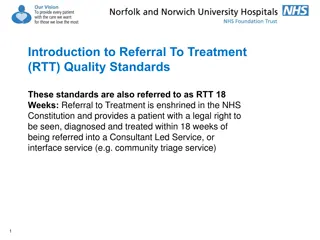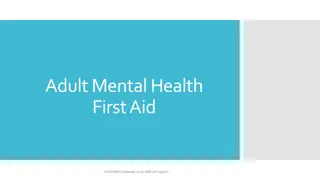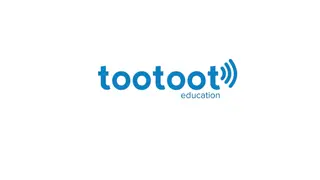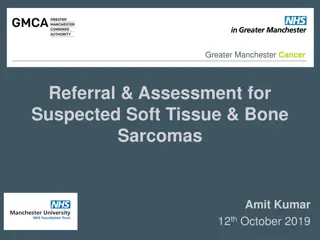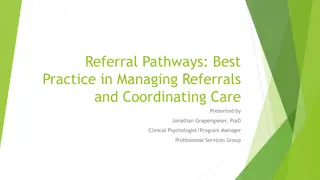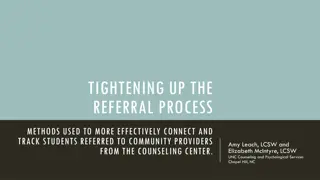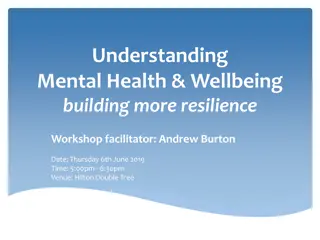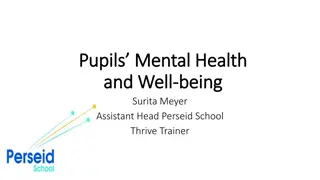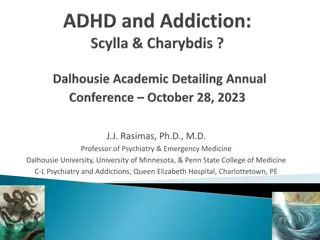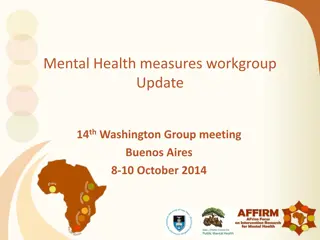Enhancing Referral Tools for Mental Health and Addictions Sector
Explore the development and implementation of referral tools to streamline access to mental health and addiction services in the North East region. Learn about the objectives, stakeholders involved, challenges addressed, and must-have features for effective referrals.
Download Presentation

Please find below an Image/Link to download the presentation.
The content on the website is provided AS IS for your information and personal use only. It may not be sold, licensed, or shared on other websites without obtaining consent from the author.If you encounter any issues during the download, it is possible that the publisher has removed the file from their server.
You are allowed to download the files provided on this website for personal or commercial use, subject to the condition that they are used lawfully. All files are the property of their respective owners.
The content on the website is provided AS IS for your information and personal use only. It may not be sold, licensed, or shared on other websites without obtaining consent from the author.
E N D
Presentation Transcript
Referral Tools for the Mental Health and Addictions (MH&A) Sector Preparing for the launch of NorthEasthealthline.ca Connect
Welcome and Introduction Jennifer Michaud, North East Local Health Integration Network
Agenda 1. Project Introduction 2. Common Referral Form 3. Data Collection 4. MH&A Data Standards 5. Next Steps 6. Questions
Participants MH&A Service Providers Ang le Desormeau South Cochrane Addictions Lisa Case Sault Area Hospital Rhea Funnell CMHA Nipissing Kali Sohm CMHA Nipissing Anne Sprack Health Sciences North North East CCAC Mathieu Litalien Janet Skuce thehealthline.ca Information Network Gabriele Davey Neil Tuomi Ryan Marttala ConnexOntario Nicole Adkin Ron Stewart North East LHIN Jennifer Michaud Mike O Shea Shana Calixte System Navigation Deana Stephen
What are we trying to achieve? Streamlined access to MH&A for clients from: Acute Care Primary Care CCAC CSS Mental Health and Addictions
Two tools: Using one referral form
Why? From the perspective of the referring source 48 LHIN-funded MH&A providers Difficult to keep tabs on all of the services and eligibility criteria Facilitates access and transitions for referring providers and clients
Why? From the perspective of MH&A organizations receiving referrals Majority are small organizations Intake person sometimes also service provider Referrals from provider and public Referrals from 5 different pathways Phone, fax, email, drop-by visits
Must-Haves for Common Referral Privacy and security requirements User friendly for clients Meet needs of referrers and providers Standardized pick-lists to help clients and providers find services Easy and quick navigation Easy and quick connection to services
Striking a Perfect Balance Collecting just enough information to start the conversation between clients and the right providers Too much information Not user-friendly Won t be completed Impossible to incorporate every data element required by every service Too little information Delays access Clients sent in wrong direction Privacy impacts Referral form not Intake or Assessment A form, not a process
North East Data Collection Gabriele Davey, thehealthline.ca Information Network
Helping people find accurate and up-to-date information
North East CCAC 2590+ service profiles for health and social services in North East LHIN ConnexOntario 650+ services profiles that serve North East LHIN from other health regions 560+ MH&A services profiles imported weekly (started Jan 2016) Data sources Data projects Provincial Services Directory Where service profiles are translated and categorized NorthEasthealthline.ca Connect NorthEasthealthline.ca Other sites for target audiences or with specialized referral tools Behavioural Supports Ontario Organized into 350+ categories including 50+ MH&A categories Launching October 2016 caregiverexchange.ca
North East CCAC 2590+ service profiles for health and social services in North East LHIN ConnexOntario 650+ services profiles that serve North East LHIN from other health regions 560+ MH&A services profiles imported weekly (started Jan 2016) MH&A Services Data sources Data projects Provincial Services Directory Where service profiles are translated and categorized NorthEasthealthline.ca Connect NorthEasthealthline.ca Other sites for target audiences or with specialized referral tools Behavioural Supports Ontario Organized into 350+ categories including 50+ MH&A categories Launching October 2016 caregiverexchange.ca
Service profile A record type used by Information and Referral systems Detailed information about a service or program Helps people decide if a service can address a need Organized into data fields Some data fields have pre-determined options Some data fields have open free-text data entry: Service Description, Fees, Application
Mental Health and Addictions Services Data Standards New data standards for MH&A have been developed through this project for free-text data fields Service Description Application Fees Data standards were based on: MOHLTC Functional Centre descriptions Existing services profiles Literature reviews Feedback from subject-matter experts
Data Standards Why? Makes it easier to find information Helps readers compare like services Improves search results Helps people navigate the complex system of services
Mental Health and Addictions Services Data Standards Content Instructions on how to use the data standards General information and referral writing style guide Specific data standards for each MH&A functional centre Instructions for words that come up frequently Status: Last call working draft (June 2016) BUT it is a living document under constant review
Data updating process Service providers update their data in one place 1. MH&A services continue to be contacted by ConnexOntario 2. Data standards are applied by the MH&A services to three data fields Service Description a. Application b. Fees c. Data sources Then data is shared. 3. Information is updated in ConnexOntario and shared with NorthEasthealthline.ca Data projects 4. Service profiles are categorized and translated in NorthEasthealhtline.ca 5. Services information displays on NorthEasthealthline.ca Connect and other sites with overlapping subject/service areas
Introduction to MH&A data standards Ryan Marttala, thehealthline.ca Information Network
Information and referral writing style Writing style originally designed for phone referral services This style is still good for the typical online reader, who skims or scans content Written at grade 6-8 literacy levels Each idea is entered only once, into the best fit data field, to avoid repetition Avoids marketing language
Information and referral writing style Bad Examples: FiveClub Residential Housing Program is a very effective substance-free environment. You can try our residential housing. Lives are changed by the district's residential housing program. This is residential housing for drug abusers. We offer safe residential housing for individuals with drug problems. Provides residential housing at a convenient location.
Information and referral writing style Bad Examples: FiveClub Residential Housing Program is a very effective substance-free environment. You can try our residential housing. Lives are changed by the district's residential housing program. This is residential housing for drug abusers. We offer safe residential housing for individuals with drug problems. Provides residential housing at a convenient location. Good example: Residential housing for people affected by substance abuse or dependence.
Information and referral writing style Highlights the most important information first Doesn t use complete sentences Don t start with: a, an, the, this, there, these, to, it Use simple or explained terminology Examples: Drop-in recreational and social supports for youth affected by alcohol abuse or dependence. Day centre with structured programs for adults living with mental illness.
Information and referral writing style Avoid most acronyms, unless they will be encountered by the public Bad Example: ICM for IDUs under CTOs. Good Example: Intensive case management for people affected by drug abuse or dependence. Services include Community Treatment Order (CTO) coordination.
Information and referral writing style Describe entry-point and publicly available services Provide details for services consistently available Examples: Outpatient treatment and support for adults living with serious mental illness. Services include one-on-one treatment and instruction on safe medication use.
Information and referral writing style Do not use personal statements Contains: I, me, my, mine, we, us, our, ours Do not use conversational statements Do you need help? Do not use subjective statements Outstanding service with rapid access to superior care!
Steps for updating a service profile 1.Download the newest version of the Data Standards document and find your functional center s Service Description 2.Using the Data Standard as a guide, write your opening summary statement 3.Identify and list basic service details 4.Do Application and Fees, too
Step 1 Find the Standard Service Description(s) Use the description(s) that best align with the service s Functional Centre
Step 2 Write your opening summary statement Select the opening text that best describes the service Example: Community-based addictions treatment for [ people / adults / youth / men / women ] affected by substance abuse or dependence[ , including those being treated with methadone or suboxone ].
Step 2 Write your opening summary statement Select or remove optional texts [ in square brackets ] Multiple options are separated by a slash (/) Example for a service with general addictions treatment for youth: Community-based addictions treatment for [ people / adults / youth / men / women ] affected by substance abuse or dependence[ , including those being treated with methadone or suboxone ]. Only the optional word youth is kept.
Step 2 Write your opening summary statement Remove or replace incorrect statements Example for an addictions treatment service that focuses on drug use: Community-based addictions treatment for youth affected by substance abuse or dependence.
Step 2 Write your opening summary statement Remove or replace incorrect statements Example for an addictions treatment service that focuses on drug use: Community-based addictions treatment for youth affected by substance abuse or dependence. Community-based addictions treatment for youth affected by drug abuse or dependence.
Step 3 Identify basic service details Use the bulleted lists in the Data Standard as a guide Some may apply, some may not Add additional service details if necessary Include unique capacity/duration details, if any Selected service details are then arranged by urgency: 1. crisis services 2. clinical services 3. support services 4. prevention services
Step 3 Identify basic service details Example: [ x ]-day programs [ x ]-week programs [ x ]-session biweekly programs early intervention outreach outreach to First Nations follow-up supports [ with other community agencies ] relapse prevention specialized assessments harm reduction (supports for the safer use of alcohol and drugs) one-on-one therapy group therapy family therapy opioid case management [ for mothers of children 6 years and younger ] peer support groups family interventions referrals to community resources services available in home [ and in schools ] services available in home, in schools, and other community settings
Step 3 Identify basic service details Example: [ x ]-day programs [ 8 ]-week programs [ x ]-session biweekly programs early intervention outreach outreach to First Nations follow-up supports [ with other community agencies ] relapse prevention specialized assessments harm reduction (supports for the safer use of alcohol and drugs) one-on-one therapy group therapy family therapy opioid case management [ for mothers of children 6 years and younger ] peer support groups family interventions referrals to community resources services available in home [ and in schools ] services available in home, in schools, and other community settings
Step 3 Identify basic service details Example: Community-based addictions treatment for youth affected by alcohol abuse or dependence. 8-week programs group therapy family interventions referrals to community resources services available in home and in schools Community-based addictions treatment for youth affected by alcohol abuse or dependence. 8-week programs include group therapy, family interventions, and referrals to community resources. Services are available in home and in schools.
Anatomy of a Service Description Example: Community-based addictions treatment for youth affected by alcohol abuse or dependence. 8-week programs include group therapy, family interventions, and referrals to community resources. Services are available in home and in schools. 1.Opening summary statement Descriptive setting (if appropriate) Main function General target population (if appropriate) 2.Capacity/duration information 3.Local service details 4.Treatment/service models (lowest priority) a. b. c.
Anatomy of a Service Description Example: Community-based addictions treatment for youth affected by alcohol abuse or dependence. 8-week programs include group therapy, family interventions, and referrals to community resources. Services are available in home and in schools. 1.Opening summary statement Descriptive setting (if appropriate) Main function General target population (if appropriate) 2.Capacity/duration information 3.Local service details 4.Treatment/service models (lowest priority) a. b. c.
Anatomy of a Service Description Example: Community-based addictions treatment for youth affected by alcohol abuse or dependence. 8-week programs include group therapy, family interventions, and referrals to community resources. Services are available in home and in schools. 1.Opening summary statement Descriptive setting (if appropriate) Main function General target population (if appropriate) 2.Capacity/duration information 3.Local service details 4.Treatment/service models (lowest priority) a. b. c.
Anatomy of a Service Description Example: Community-based addictions treatment for youth affected by alcohol abuse or dependence. 8-week programs include group therapy, family interventions, and referrals to community resources. Services are available in home and in schools. 1.Opening summary statement Descriptive setting (if appropriate) Main function General target population (if appropriate) 2.Capacity/duration information 3.Local service details 4.Treatment/service models (lowest priority) a. b. c.
Anatomy of a Service Description Example: Community-based addictions treatment for youth affected by alcohol abuse or dependence. 8-week programs include group therapy, family interventions, and referrals to community resources. Services are available in home and in schools. 1.Opening summary statement Descriptive setting (if appropriate) Main function General target population (if appropriate) 2.Capacity/duration information 3.Local service details 4.Treatment/service models (lowest priority) a. b. c.
Anatomy of a Service Description Example: Community-based addictions treatment for youth affected by alcohol abuse or dependence. 8-week programs include group therapy, family interventions, and referrals to community resources. Services are available in home and in schools. 1.Opening summary statement Descriptive setting (if appropriate) Main function General target population (if appropriate) 2.Capacity/duration information 3.Local service details 4.Treatment/service models (lowest priority) a. b. c.
Anatomy of a Service Description Example: Community-based addictions treatment for youth affected by alcohol abuse or dependence. 8-week programs include group therapy, family interventions, and referrals to community resources. Services are available in home and in schools. 4. Treatment/service models (lowest priority) Optional sentences regarding treatment and/or service models are left to the end e.g., Multi-disciplinary team includes [ list of job titles ]. e.g., Treatment models include e.g., [ Regional / District ] support for related programs.
Information and referral writing style We have standards, but we are all different! Customize the information to best describe the local service Check the Data Standard section 5 ( Consistent Use of High- Frequency Words ) to check for flagged terms Example: Only use case management for direct one-on-one services. Prefer care coordination for third-party agents. Example: Do not use individuals . Prefer people for all ages, prefer adults when children and youth are excluded. Example: Only use education for formal group learning. Prefer instruction for informal/one-on-one learning. Fully customized descriptions are possible, and can be made consistent by using the writing style guidelines (section 4) and the overview for the Service Description field (section 8)


